“According to well-known electrodynamic laws, an electron moving in a magnetic field is acted upon by a force which runs perpendicular to the direction of motion of the electron and to the direction of the magnetic field, and whose magnitude is easily determined.” -Pieter Zeeman
We're now full-on into summer here at Starts With A Bang, but that doesn't mean that science slows down at all! Our podcasts are killer with a new one coming soon, the 4th of July has just passed giving way to a huge slew of fantastic outdoor activities, and we've spent the first half of last week focused on astronomy and the latter half with a fun focus on particle physics! Here's some of what we covered:
- Can gravitational waves let us peek inside a black hole? (for Ask Ethan),
- Ceres' bright spots are salt, likely due to subsurface water (for Mostly Mute Monday),
- Yes, New York Times, there is a scientific method,
- Venus, not Earth, may have been our Solar System's best chance at life,
- Grand unification may be a dead-end for physics, and
- Why doesn't our Universe have magnetic monopoles?
Our comments of the week is our best chance to hear your thoughts on these incredible science stories, so without ado, let's dive in!
From Dean on the collateral damage of fireworks: "I’ll also say that fireworks can be incredibly stressful for a military veterans dealing with PTSD."
I sometimes think that PTSD was better understood in the early 20th century, where they called it "shell shock" and recognized that it had something to do with the concussive force and trauma of an explosion on someone's psychological state. There were even post-WWII films out about how to treat it, and even the macho culture of the military seemed to be okay with "yeah, this happened to me and I got it," the same way any injury was treated. I wish we treated mental health with the same compassion, as a society, that we treat physical health. We all deserve to be well, inside and out.
Ilustration of a black hole and its surrounding, accelerating and infalling accretion disk. Image credit: NASA.
From Philip Coleman on black holes: "Time Sucked into anti-time with all for balance absolute equal for the anti-equal. Two fabrics unequal are balanced. Only escape is at near end of processes."
It's important to recognize that except for the singularity, where time and space come to a "point" and hence cease to flow (or make sense), there is no "anti-time" at all; there is only forward-moving time. Sure, anything that's massless doesn't experience time at all, but from our outside perspective (being massive creatures, we're immune to this perspective), we see that time only moves in one direction. Arguably, something with an imaginary mass might be tachyonic, and might experience what we'd consider "anti-time" to be, but according to quantum field theory, the only tachyons that are allowed are ghost particles, which must decouple from the theory.
In other words, I'm pretty sure that there's no anti-time, and except for the last sentence you cite (which refers to Hawking radiation at the end-state of a black hole), I wouldn't worry about the rest.
Anything crossing the black hole’s event horizon will never be visible again. Image credit: public domain work by Brandon Defrise Carter (presumed).
From Omega Centauri on illuminating a black hole with gravitational waves: "But if you illuminated a BH with gravitational waves, and observed what happens to these waves as that interact with the BH, could you work out what is happening inside the horizon."
You can only illuminate the black hole outside the event horizon, since any waves that fall in will merge with the singularity, just as any light that falls in will add to the black hole's mass as well. So you can get a "backlit" view of spacetime outside the event horizon with gravitational waves, just as you can with light. But inside the horizon? Nope.
From Oleg Shevchenko on an unrelated question: "If the star Betelgeuse explodes how serious the consequences can sense our planet if its pole faces in our direction?"
Even in the worst case scenario that you outline, the distance is so great and the Earth's magnetic field is so intact that it will be no worse than a large solar flare aimed at Earth as far as our effects go. There's a tremendously good piece that Jillian Scudder wrote back when Starts With A Bang was full-time at Medium for us on Betelgeuse's brightness in the sky; it's not so bad for us.
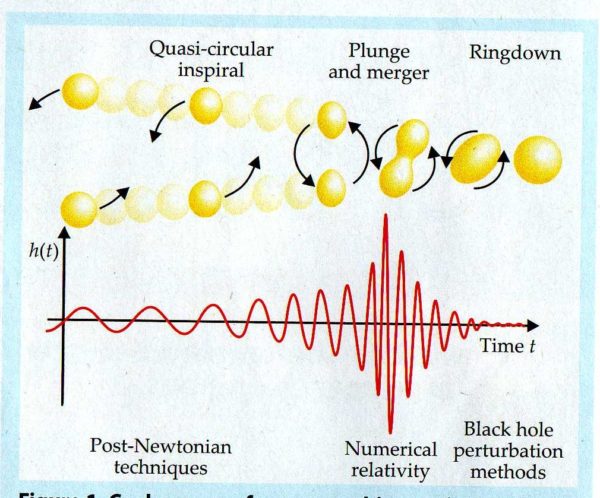 Inspiral, merger and ringdown phases of a binary black hole merger. Image credit: Baumgarte and Shapiro 2011.
Inspiral, merger and ringdown phases of a binary black hole merger. Image credit: Baumgarte and Shapiro 2011.
From Adam on gravitational waves: "[I]sn’t LIGO detecting gravitational ways resulting from merging black holes during the ringdown phase, when the individual singularities are already inside the newly merged event horizon? Those weren’t absorbed by the black hole, but were emanated from it. And that loss of energy resulted in the loss of mass of the final black hole… so do these statements only refer to particles?"
I would normally talk about what's happening outside the event horizon and refer to a diagram like one above, but Michael Kelsey beat me to it and gave a spectacular explanation!
LIGO detects gravitational waves from both the inspiral and ringdown phases. In both cases, the waves arise from the motion of the two black holes through the spacetime _outside_ the event horizon(s), not from activity within them.
During inspiral, the quadrupole moment of the whole system as it rotates around its center of mass is what generates the waves.
During ringdown, the event horizon is very briefly not spherical, but has some extremely complex shape (computable in GR) determined by the initial masses and spins of the two black holes.
The ringdown waves are generated in the spacetime _outside_ the event horizion by the “relaxation” of that complex shape to the sphere required for a single black hole.
I can do no better. Kudos!
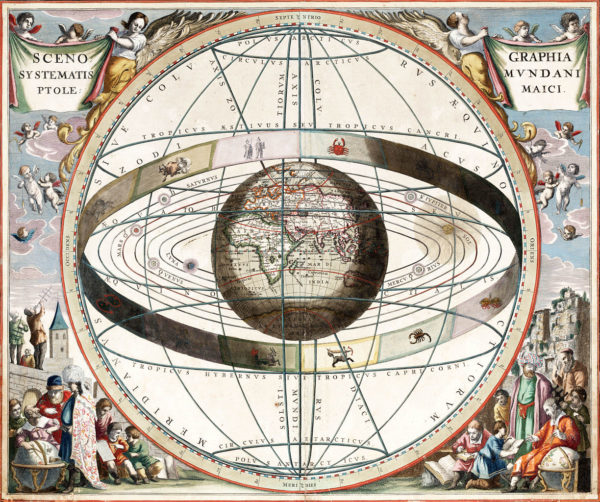 Chart showing signs of the zodiac and the solar system with world at centre. From Andreas Cellarius Harmonia Macrocosmica, 1660/61. Image credit: Loon, J. van (Johannes), ca. 1611-1686.
Chart showing signs of the zodiac and the solar system with world at centre. From Andreas Cellarius Harmonia Macrocosmica, 1660/61. Image credit: Loon, J. van (Johannes), ca. 1611-1686.
From eric on peer review and replication: "That’s really what separated (for example) the science of chemistry from earlier alchemy; alchemists worked to keep their experiments secret, scientists work to make their experiments public. One of the disturbing things (to me) about the corporatization of pharmaceutical research is the extent to which secret research and patents play a part. And oh look, at the same time we are discovering using meta-studies that many of the drugs that make it to market don’t live up to the hype. Coincidence? Unlikely. Sharing data and results, so that your peers can help you find your mistakes (because yes, you will make some) is pretty critical to the scientific endeavor."
Without any accountability for your work, you could claim anything you wanted. If no one can view, detail, repeat, reproduce or dissect your study, how can one separate fraud from scrupulous science? (Ahem, Andrea Rossi?) How can one separate competent research from someone fooling themselves? (Robert Shawyer? Sonny White?) And how can people make policy or external decisions when they don't have all the relevant information?
When I wrote my critique, I assumed open and honest methodologies, and perhaps that's not a great assumption to make. There are a lot of mistakes out there, but there are a lot of worse-than-mistakes out there, too, and being open with your information is the first line of defense that the truth has against scientific malpractice.
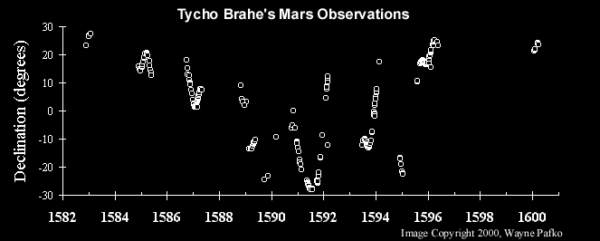 Tycho Brahe’s Mars data, fitted to Kepler’s theory. Image credit: Wayne Pafko, 2000, via http://www.pafko.com/tycho/observe.html.
Tycho Brahe’s Mars data, fitted to Kepler’s theory. Image credit: Wayne Pafko, 2000, via http://www.pafko.com/tycho/observe.html.
From Julian Frost on the null hypothesis: "My understanding is that in the scientific method, you actively have to try to disprove your hypothesis. This is what makes the scientific method so difficult (nobody wants to prove themselves wrong) and yet so valuable as a tool for getting at the truth. It actively tries to stop you from “fooling yourself”, to paraphrase Feynman."
It's not so much that you have to try to disprove your hypothesis, but -- at least as I see it -- you have to ask yourself (as Sean T noted) whether:
- a new hypothesis beyond what's established is necessary,
- what consequences would be different with the new hypothesis versus the old, established consensus model,
- whether that information is available and what it says,
- and what the full suite of relevant scientific evidence says.
Some people claim to want to prove themselves wrong, yet refuse to give up on their discredited ideas when the evidence comes in. (Vilenkin did this with cosmic strings; Carr did this with primordial black holes; Hoyle and Burbidge did this with the steady-state model, and the list goes on.) It isn't always your responsibility to prove your idea wrong, but it's the responsibility of the scientific community to robustly test all ideas against one another, and to pick the ones that best describe the Universe in the regime they are studying.
This is why, IMO, galaxy dynamics people often prefer MOND to dark matter, and no one else does.
From Denier on the habitability of Venus vs. Earth: "There is so much we don’t know that hypothesizing about life being possible on Venus is little more than fantasy. As pointed out, the rotation of Venus is a problem and we have no idea why it is what it is. Back in 2012 it was discovered the rotation of Venus had slowed by a whopping 6.5 minutes in only 16 years. Before it was discovered no one even thought that was possible, and even now no one really has a good handle on it.
Scientists cite the importance of plate tectonics to the formation of life but Stromalite fossils date back to 3.5 billion years ago while accepted theory states plate tectonics on Earth didn’t start until half a billion years later. Life seemed to do just fine before plate tectonics.
What is key? What isn’t? We’re still in the era of making guesses."
I agree with this 100%. What caused Venus to rotate the way it does, anyway? Did something collide with it and knock it over? Did it have a resurfacing event more catastrophic than the one that occurred in early Earth's history: with the event that created the Moon?
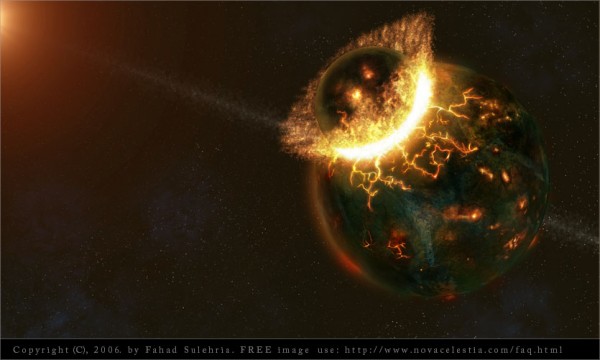 Image credit: Fahad Sulehria of http://www.novacelestia.com/.
Image credit: Fahad Sulehria of http://www.novacelestia.com/.
And what is-or-isn't essential to life? Does a world need to rotate at all, or can it be locked? Can a H/He envelope exist, or is that prohibitive? Must it be carbon based; could it use liquid methane instead of liquid water?
It's just a hunch on my part, but I have a feeling that life is far more robust and varied and diverse than we've imagined so far. Perhaps in our lifetimes, we'll actually get to find out.
From MP on philosophy and physics: "Hawking is adding a philosophical bent towards physics?"
This is, I can only assume, in response to the Stephen Hawking quote I put at the top of my article:
“Even if there is only one possible unified theory, it is just a set of rules and equations. What is it that breathes fire into the equations and makes a universe for them to describe?” -Stephen Hawking
This is a question of physics, not necessarily of philosophy. It might sound philosophical, but it's something that will be open to experimental and theoretical investigation if you phrase it differently. For example:
Why does the Universe have the equations, constants, particles and interactions that it has governing it, and how were those parameters determined?
We could have asked that question about matter about 200 years ago, and the answer turned out to be given by atomic theory: how nuclei were made up of configurations with different numbers of protons, and that determined the elements' properties, while the electron configurations and how the various atoms were bound together determined everything from molecular properties to macroscopic ones. Perhaps there is a grand unified theory after all, and perhaps the way the unification breaks determines the Universe we have. It's a physical idea, not just a philosophical one.
From Denier on Grand Unification: "The QM mediator of gravity is the graviton, which just happens to look like a double copy of a gluon."
Woah! So... I was with you up until this part. Asymptotic freedom -- of particles with color charge -- means that when they're close together the force asymptotes to zero, and the farther apart they get, the larger the force between them gets. Because quarks and gluons are colored (see above; it's accurate!) but individual bound states (mesons and baryons) are colorless, the inter-bound-state forces are extremely short range.
But how is a graviton like a double copy of a gluon? The gauge theory, the force structure, the magnitudes, etc., are all so different. How do you put this together? I'm curious!
Ted Cruz, with a loaded statement from a questionable science news source, during a hearing on climate change on December 8, 2015. Image credit: SAUL LOEB/AFP/Getty Images.
From See Noevo on... well, I don't know: "I’d post this question myself but I’m not allowed to comment within Greg Laden’s blogs.
Greg had a great preoccupation with and focus on the presidential race recently. In fact, he may have gone a week or three without a single climate change post!!!
Just posts about the primaries and the presidential race.
The question for Greg is:
Do you agree that Hillary Clinton should NOT have been indicted by James Comey?"
This really adds a lot to the discussion of... nope, done lying here. So the question for all of you is this:
Should the anti-evolution and thread-hijacking commenter See Noevo:
— Ethan Siegel (@StartsWithABang) July 10, 2016
Voting will remain open for the next 5 days. It will take a 2/3 majority of voters to ban somebody. Let's try it out. DEMOCRACY!
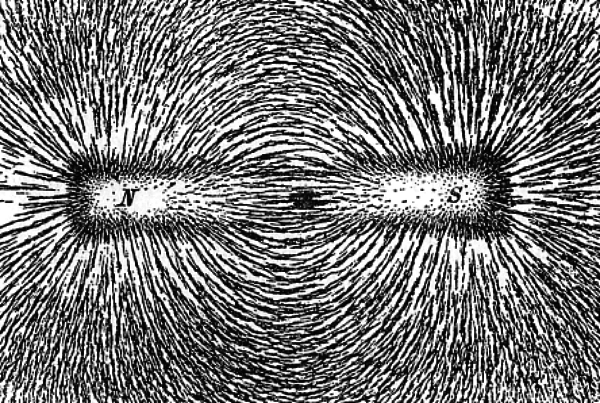 Magnetic field lines, as illustrated by a bar magnet: a magnetic dipole. There’s no such thing as a north or south magnetic pole — a monopole — by itself, though. Image credit: Newton Henry Black, Harvey N. Davis (1913) Practical Physics, The MacMillan Co., USA, p. 242, fig. 200.
Magnetic field lines, as illustrated by a bar magnet: a magnetic dipole. There’s no such thing as a north or south magnetic pole — a monopole — by itself, though. Image credit: Newton Henry Black, Harvey N. Davis (1913) Practical Physics, The MacMillan Co., USA, p. 242, fig. 200.
And finally, from Michael Kelsey on Blas Cabrera's magnetic monopole: "Blas’s candidate event is a really clean signal: just from the plot you show, we can estimate the noise uncertainty as about 0.15 magnetons (full width of baseline is about 0.5, divide by sqrt(12) to get RMS). The systematic error due to the LN2 changes is also less than 0.5. So the candidate signal is 8 +- 0.52, or 15.38 sigma.
That’s about as close to “certain” as you can get. That is, it appears to my experience that the signal from the equipment is a real signal corresponding to a physical event, not noise or interference or something. But it’s pretty clear from subsequent research that it probably wasn’t a magnetic monopole ?"
It's an incredible signal; I'm not surprised that it has a ~15 sigma statistical significance. I mean, just from visual inspection, you can see there's nothing else like it in the data.
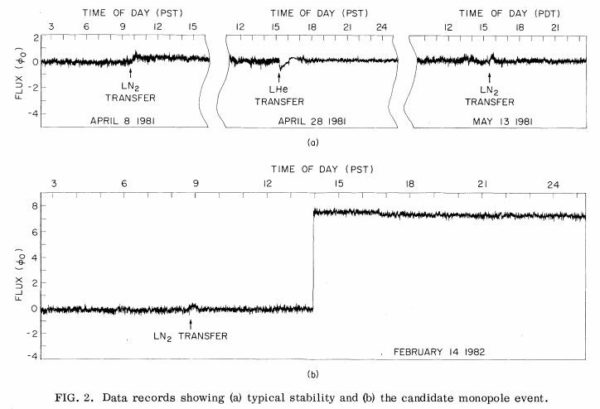 Image credit: Cabrera B. (1982). First Results from a Superconductive Detector for Moving Magnetic Monopoles, Physical Review Letters, 48 (20) 1378–1381.
Image credit: Cabrera B. (1982). First Results from a Superconductive Detector for Moving Magnetic Monopoles, Physical Review Letters, 48 (20) 1378–1381.
The big question I've always had was, if the Universe isn't filled with magnetic monopoles, what exactly happened here? Was it an act of sabotage? Was it the one magnetic monopole allowed to be in the post-inflation Universe? Is there something very exotic that happened under that one particular circumstance that never happened again?
Unless it was sabotage and the saboteur comes forward, we may never know. Thankfully, Blas Cabrera doesn't think it was a conspiracy or anything more than a fluke, and he's continued to do good science and make solid contributions to physics in varying ways over the past 34 years. May we all be so humble and not wedded to our most fantastic results if they don't hold up to further scrutiny!


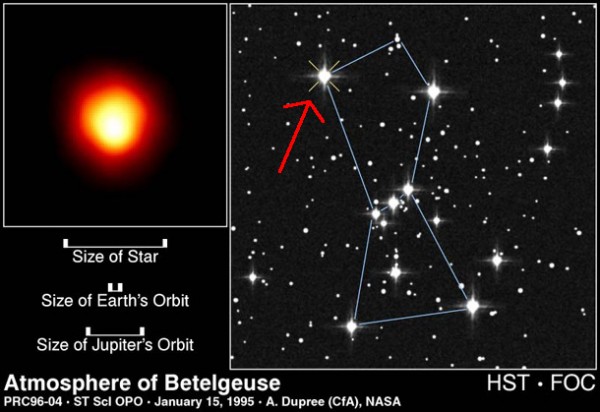


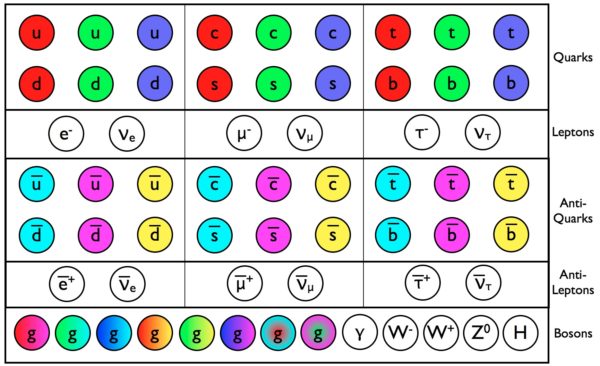
Some housekeeping still needed from week #116:
Ethan: “Nature may ARRIVE AT rest mass values THROUGH A PROCESS completely unrelated to the Planck mass.”
Me: “If that’s so, then rest mass values were not always what they are now, but instead “arrived at” current values via a “process” over time.”
What say you, Ethan?
Regarding purported progress, if any, in science’s version of the Good Housekeeping Seal of Approval…
“To announce that first Peer Review Congress [in 1986], I wrote:
“There are scarcely any bars to eventual publication. There seems to be no study too fragmented, no hypothesis too trivial, no literature citation too biased or too egotistical, no design too warped, no methodology too bungled, no presentation of results too inaccurate, too obscure, and too contradictory, no analysis too self-serving, no argument too circular, no conclusions too trifling or too unjustified, and no grammar and syntax too offensive for a paper to end up in print”10.
Unfortunately, that statement is still true today, and I'm not just talking about predatory journals. That said, I am confident that the Peer Review Congress scheduled for 2017 will be asking more incisive, actionable questions than ever before.”
http://www.nature.com/news/let-s-make-peer-review-scientific-1.20194
Good luck.
@Ethan: Blas Cabrera certainly has continued a strong and active career! I'm a member of both the CDMS and its successor, the SuperCDMS, Collaborations (cryogenic dark matter detectors), and Blas is heavily involved in the project, both the "big picture" and many details of the detector design.
To Mikey the SLACer #3:
“I’m a member of both the CDMS and its successor, the SuperCDMS, Collaborations (cryogenic dark matter detectors)…”
Congratulations.
How has CDMS and its successor succeeded in the last dozen years?
Back in 2004 things weren’t too hot for the cool crowd:
“The most powerful search yet for the Universe's missing matter has come up empty handed, contradicting an earlier study that claimed to have seen new particles.
Researchers from the Cryogenic Dark Matter Search II (CDMSII) say they are pleased with their first results, which show that their detector is working and set new constraints on how the so-far undetected matter can behave, if it exists.
… However since it started running in November last year, the detector has not seen a single WIMP.
… Physicists with the CDMSII experiment say they will now add another 24 crystals to the detector, increasing its sensitivity tenfold. If they still fail to find something, then theorists who believe in supersymmetry may have to rethink their ideas. "CDMSII isn't exerting an annoying pressure on theorists yet," says Nelson. "But they're starting to feel it."”
http://www.nature.com/news/1998/040503/full/news040503-7.html
Do you feel it?
Don't get ahead of yourself; Twattifying this has merely left things at a level below mob rule, supermajority gesture notwithstanding.
The poll would be more fair (and, I suspect more conclusive) if it required the credentials pair of someone who has actually at least commented here as a prerequisite to voting. I mean, it doesn't exactly take all that long to whomp up a Twatter account. (I was vote 44 and only vote 44, from a long-standing account, BTW.)
I'm not a Patreon member, but I would imagine you should give the voice of your Patreons more weight than the voice of a random person who may create a twitter account just to vote one way or another.
FWIW, I have commented before that he should be banned, and my vote reflected this.
I don't know why anyone wastes their time engaging him every time he makes a comment. It is such a waste of time and space and really takes away from what are usually otherwise great conversations in the comments.
@Ethan wrote
It comes from the intriguing work of Sakurai prize winning physicists Zvi Bern, Lance Dixon, and David Kosower.
http://academic.evergreen.edu/z/zita/articles/SciAm/2012/2012Unificatio…
SN:
You got an answer, from Narad (IIRC): you've completely misunderstood Ethan's sentence. Really SN, you're not even showing a junior high reading comprehension level here. But pretending for the moment your question is sincere, here you go: Ethan clearly means "some physics unrelated to plank give rest masses the values they have", not "rest masses change over time."
SN:
Thanks for the link, that was a good and relevant article. Though I think the author is a bit too harsh early on; personally, I think the reason peer review is very poor at finding fraud is because the system was never intended or designed to find fraud.
And while I know your editorial comment was a sarcastic flourish, I will also wish the conference organizers (a sincere) good luck!
I don't know if anyone remembers, but a looong way back, I said that the inflation of the universe could have been "powered" by the collapse of the extra dimensions, as if it were a phase change with dimensions "freezing out".
I did recently find another source for a paper on the subject, but keep bloody well forgetting to make note and bring it in.
If anyone is still interested, say so, that plus the embarrassment of admitting the failure here may make me remember to bring it, and if nobody remembers or cares, I won't feel too bad if I keep forgetting...
@Wow #10
If you don't bring that paper in then it represents a complete and total failure on your part. You would be considered nothing but a blowhard who doesn't back anything up. Without that paper your worth, not only as a contributor to this board but also as a human being, is zero. Life has now come to the point where you can choose to bring the paper in or sit in a park somewhere rocking back and forth while muttering to your socks.
Nope, it doesn't demonstrate a complete and total failure on my part, it demonstrates a failure to bring forth the information I said I'd bring.
When you promised your nephew you'd help him with his homework and work called you away instead, was that a complete and total failure on your part????
The only failure to date is yours to approach life without histrionics and vitriol, dearie.
I take it that if I do bring the reference to the paper, denier, that you'll be worthless and have brought nothing to life at all, right?
After all, what's sauce for the goose is sauce for the gander. Or is hypocrisy your metier?
@Wow #12
It is a common fallacy by misguided soles that pieces of their lives can be totally compartmentalized. Sadly the truth is more like the RMS Titanic, also thought to be unsinkable due to compartmentalization. Failure of the level of not bringing in that paper would simply cascade from one part of your life to the next until it was icy cold failure everywhere you looked. As you gasped for air while depression and failure swamp every part of your existence, know that it could have all been avoided if only you had remembered to bring in that paper.
That's mostly a problem with the sneakers. The boots and sandals tend to be less, well, sneaky.
Regarding SN, I think it's a pitty that the comment section hasn't technically evolved, in the sense that replies on comments are seperated into threads that one could open and close. It would make it easier to ignore posts you don't like and the discussions that are meaningless. With perhaps also popularity and recomendations as you have for example with the nytimes and similar forbes. Now you need to dig through everything and things become a mess, and it makes it impossible to ignore someone.
Unfortunately, it still needs someone to read all posts in the first instance, then decide on the appropriate bin to place it. Sometimes, one has to cut to the chase by chastising once or twice, then cut that person off if they persist, Saves a lot of space, and angst.
:)
The scroll wheel is your friend. Just because someone posts it doesn't mean you're under any social obligation to read it.
IMO its easy and only takes a few seconds to scan the "Recent Comments" sidebar, look for the names of the more reasonable posters, click on those, and just not bother with the rest (and if you include me in 'the rest,' I won't be offended :) ).
"The scroll wheel is your friend. Just because someone posts it doesn’t mean you’re under any social obligation to read it. "
Or just scan the begining. If the first line doesn't give an indication that you will want to read it, then it's not necessarily worth your time.
Though your method is acceptable, others do not wish to do that.
See, for example Sean T's posts to that credulous moron Chelle recently.
"It is a common fallacy by misguided soles "
To spell things wrong?
Moreover, how does your common fallacy not pertain to your posts, Denier?
Pointing out and screaming "BAD PERSON!" to hide your own inadequacies only brings attention to your desperate desire to hide them.
@Wow
Still no paper? So disappointing. I think we were all hoping you'd come through. Maybe you still will. I say we give it 24 hours. If by this time tomorrow there is still no paper it will be time to move on and know that you let everyone down.
@wow,
Good choice of words …
"Credulity is not simply a belief in something that may be false. The subject of the belief may even be correct, but a credulous person will believe it without good evidence."
Denier, still no desire to see it?
Chelle, so what? You're still banned.
Wow,
"so what?"
So the people at the LHC are also 'credulous', claiming that the experiment is safe, but they have no good evidence. First the UHECR's where thousands of times more energetic, now it is only 50. There is hardly any difference between them and I, we only picked different sides of the same coin
Um...the LHC has been running high luminosity beams since at least 2011. Running the same beams for 5+ years and not creating strangelets or causing a cascade of atomic dissolution is pretty strong evidence that the next run of the exact same beam will not create strangelets or cause a cascade of atomic dissolution.
beams have been runnning at current luminosities <a href="
I've only encountered the "by the other side of the same token" conflation once before in my life. Anyway, it's unfortunate that you didn't stick with the "my job is done" routine from four months ago. Selah.
*plonk*
“Um…the LHC has been running high luminosity beams since at least 2011. Running the same beams for 5+ years and not creating strangelets or causing a cascade of atomic dissolution is pretty strong evidence that the next run of the exact same beam will not create strangelets or cause a cascade of atomic dissolution.”
Be careful of those proton packs, guys.
And don’t cross the beams.
https://www.youtube.com/watch?v=IHBmNE-G2E4
@SN
FYI
"It’s full speed ahead for the Large Hadron Collider (LHC), as it shatters its own records one after the other, achieving record luminosity, record numbers of bunches and a record beam lifespan.
Some 2076 bunches of 120 billion protons are currently circulating in the ring in each direction. At the end of June, beams were maintained in the accelerator for a record 37 consecutive hours! But the main indicator of success for the operators is luminosity, the measurement of the number of potential collisions in a given time period. On 29 June, peak luminosity (the number of potential collisions per second and per surface unit) exceeded 10^34cm-2s^-1. "
So the faster they go the more often they collide, with now collisions that are only 50 times lighter than UHECR's, but with a frequency that is a 1.000.000.000 times higher. Think off a repetitive strain injury (RSI) pain in muscles and nerves caused by repetitive movement and overuse.
@Narad
I saw Wow bring up my name … alright, flip a coin, gambling … "Early people used the knucklebones of sheep as dice. Some people develop a psychological addiction to gambling, and will risk even food and shelter to continue.".
"Wow,
“so what?”
So the people at the LHC are also ‘credulous’"
No they aren't. Just because YOU are chelle and trolling where you've been banned doesn't mean Denier, for example, is Chelle and trolling where he's been banned.
A simple fact that is far too simple for a moron like yourself.
"@Narad
I saw Wow bring up my name "
And banned. But you don't want REASONS, you want EXCUSES.
"So the faster they go the more often they collide"
Ah, for anyone out there wondering if this is true, this is a complete load of bollocks.
Maximum speed of a particle is the speed of light in a vacuum. Which occurs at far far lower energies, therefore these particles AREN'T going any faster.
If you have had any suspicion about whether chelle is a moron or not, pontificating without any knowledge, this should indicate that your suspicion about the idiot are completely confirmed.
@Wow #32,
What?!
Of course the particles collide more often in the LHC as their velocity increases, and thus the luminosity increases since the upgrade. Basically the relativistic mass of a particle increases with velocity and tends to infinity as the velocity approaches the speed of light. In practical terms our protons are moving a very small fraction below the speed of light. As we increase the energy (and momentum) they only get a very small fraction closer to the velocity of light - never reaching it. However, their energy and momentum do increase considerably. For a given momentum, our magnets need to provide a force necessary to bend the beam around in the 27 km. The increase in momentum is exactly reflected in the increased force we have to apply with these magnets as we increase the energy of the beam.